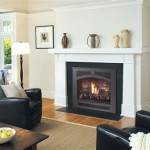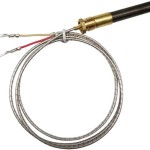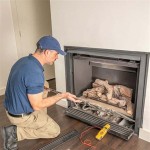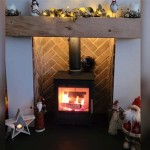```html
Gas Fireplace Log Placement: A Comprehensive Guide
Achieving an aesthetically pleasing and functionally effective gas fireplace relies heavily on the proper placement of the gas logs. Incorrect placement can lead to inefficient heating, sooting, and potentially hazardous carbon monoxide production. Understanding the principles behind proper log placement is crucial for safe and enjoyable operation of the gas fireplace.
The primary objective of gas log placement is to ensure even flame distribution across the entire log set while maintaining adequate ventilation for the burner. This allows the gas to burn cleanly and efficiently, maximizing heat output and minimizing the risk of carbon monoxide build-up. The specific arrangement will vary depending on the make and model of the gas fireplace, but some general guidelines apply universally.
Understanding the Fireplace Components
Before arranging the gas logs, familiarity with the fireplace's components is necessary. The burner is the central element and is typically a long, slotted pipe or a series of jets that distribute the gas. The pilot light ignites the gas, and the thermocouple or thermopile senses the pilot flame to keep the gas valve open. Finally, the logs themselves are ceramic or refractory fiber replicas of natural wood, designed to withstand high temperatures.
The log grate, if present, provides a platform for the logs, elevating them slightly above the burner. This elevation facilitates airflow around the burner and helps to prevent the logs from directly obstructing the gas jets. Some fireplaces have a designated log support system instead of a grate. Regardless of the support system, the goal is to create space between the burner and the logs.
Key Principles of Gas Log Placement
Several fundamental principles govern the proper placement of gas logs. Ignoring these principles can negatively impact the fireplace's performance and safety.
Ventilation: Adequate ventilation is paramount. The logs must be arranged in a way that allows sufficient airflow to the burner. Obstructing the burner with logs can lead to incomplete combustion, resulting in soot and carbon monoxide. Fireplace manufacturers provide specific instructions regarding minimum clearances and log arrangements to ensure proper ventilation.
Burner Coverage: The logs should be positioned to evenly distribute the flames across the entire log set. This creates a realistic-looking fire and maximizes heat output. The flames should lick at the underside of the logs and wrap around them naturally. Avoid concentrating the flames in one area, as this can lead to uneven heating and potential damage.
Pilot Light Accessibility: The pilot light must remain unobstructed by the logs. The pilot light is responsible for igniting the main burner, and if it is blocked, the fireplace will not function properly. Carefully position the logs to allow for easy visual inspection and maintenance of the pilot light.
Step-by-Step Log Placement Instructions
The following steps provide a general guideline for placing gas logs. Always refer to the manufacturer's instructions for specific models, as these instructions supersede any general advice.
Step 1: Consult the Manual: The manufacturer's manual is the definitive source of information for gas log placement. It provides specific diagrams and instructions tailored to the particular fireplace model. Adhering to these instructions is critical for safe and efficient operation.
Step 2: Position the Base Log: Most gas log sets include a base log or a rear log that sits directly on the grate or log support. This log typically has a specific orientation and is designed to provide a foundation for the other logs. Follow the manual's instructions for positioning the base log correctly. It often has notches or grooves that align with the burner or support system.
Step 3: Arrange the Remaining Logs: After positioning the base log, arrange the remaining logs according to the manual's instructions. Pay close attention to the orientation and placement of each log. The logs are usually numbered or labeled to indicate their correct position. Aim for a natural-looking arrangement that allows for adequate ventilation around the burner.
Step 4: Check Flame Pattern: After arranging the logs, turn on the fireplace and observe the flame pattern. The flames should be evenly distributed across the log set and should not be obstructed by any of the logs. Adjust the log placement as needed to achieve optimal flame distribution. If the flames are too high or too low, consult the manual for troubleshooting tips.
Step 5: Verify Pilot Light Accessibility: Ensure that the pilot light is easily accessible for inspection and maintenance. The pilot flame should be visible and should not be flickering excessively. If the pilot light is difficult to access or the flame is unstable, readjust the log placement accordingly.
Step 6: Carbon Monoxide Detector: It is imperative to have a working carbon monoxide detector installed in the vicinity of the gas fireplace. Routinely test the detector to ensure it is functioning correctly. Carbon monoxide is a colorless and odorless gas, and a detector is the only way to detect its presence.
Proper gas log placement is essential for the safe and efficient operation of a gas fireplace. By understanding the principles of ventilation, burner coverage, and pilot light accessibility, and by carefully following the manufacturer's instructions, users can enjoy the warmth and ambiance of a gas fireplace without compromising their safety.
```
How To Select And Install A Gas Fireplace Log Set Fireplaces Direct Learning Center

Fireplace And Gas Log Lighting Instructions

How To Select And Install A Gas Fireplace Log Set Fireplaces Direct Learning Center

Installation Amp Operating Instructions For Fireplace Gas Logs Sure Heat
.png?strip=all)
How To Install A Log Lighter Fireplace Gas Starter Pipe

Vent Free Scvfmr Log Manual Sure Heat Manufacturing

How To Put In A Gas Log Set For Fireplace
.png?strip=all)
How To Install A Log Lighter Fireplace Gas Starter Pipe

Page 2 Of Lennox Hearth Indoor Fireplace Mpd 3530 Series User Guide Gas Logs

How Long Do Gas Logs Last To Replace Fireplace
Related Posts








